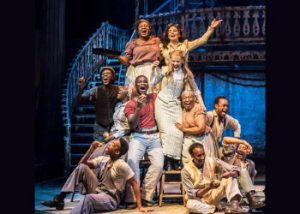
Enduring Love
The story of Show Boat covers the period from the 1880s to the 1920s, travelling from the Mississippi River to Chicago across three generations. At first Cap’n Andy introduces the acting troupe as “one big happy family”. Twenty scenes later, the full cast is back on that same quay, dancing with only the make-up and footlights to disguise the fact that this happy family have been torn apart in a harsh world, all while the Mississippi River keeps rolling along. It is worth noting here however, that each production, whether film or theatre, has a different ending.
Cotton Blossom
Over the time period that Show Boat is set, it was common for people to travel miles to see performances on the real Cotton Blossom ship moored on the Mississippi River which was busy with trade and traders and riverside towns prospered. Life revolved around the Mississippi with strict rules for morality and behaviour, though these were based on false concepts of economic and racial superiority.


Enduring Love
Everyone tells Magnolia that Gaylord is no good, but she marries him anyway. They move to Chicago, but his womanising, gambling and debts cause him to suddenly leave her and she must earn her own way. Julie knows the enduring love of women who must make their own way in life. When Magnolia assumes that if she had known that the man she loved was no good, she would stop loving him. Julie tells her that once you fall in love, it’s too late. This is why you have to be careful who you fall in love with.
Despite her undying love for Gaylord after he deserts her, Magnolia copes with life. Ironically, Magnolia is more successful without Gaylord and Julie could have been if she hadn’t found alcohol.


Racial prejudice
The two themes in the story of racism and enduring love overlap in the character of Julie who can pass for being white even though her mother was black. Julie suffers racism a number of times including Ellie’s hysterical renouncing of their friendship as soon as her background is revealed,. Again when the local sheriff attempts to arrest Julie and her husband for miscegenation, until Steve manages to convince him that he too has ‘some Negro blood’. And again when the sheriff tells the Cotton Blossom’s Captain Andy that Julie will have to leave because if people found out that a black woman was passing herself off as white, there would be trouble.
The characters of Queenie and Joe, workers on the Cotton Blossom, paradoxically both reinforce and erode racial stereotypes at the same time. Queenie represents the black mammy and he the lazy black male, yet both play characters who have a real, affectionate relationship. Joe is less of a lazy man, but rather a man moving at the pace of the river, a wise man who looks at the world with compassion.
The story is a product of its times and therefore an extremely useful tool for discussion.
